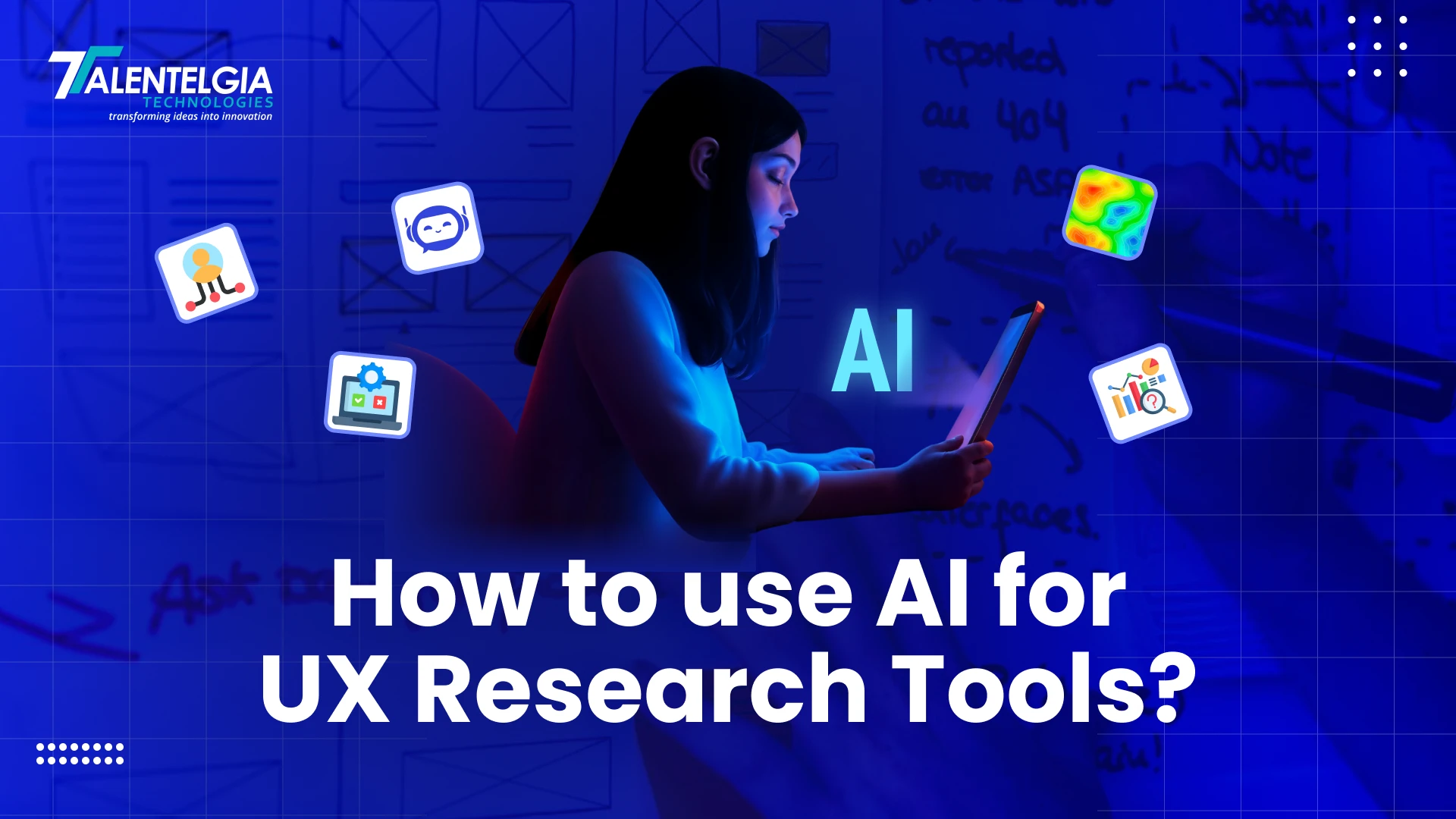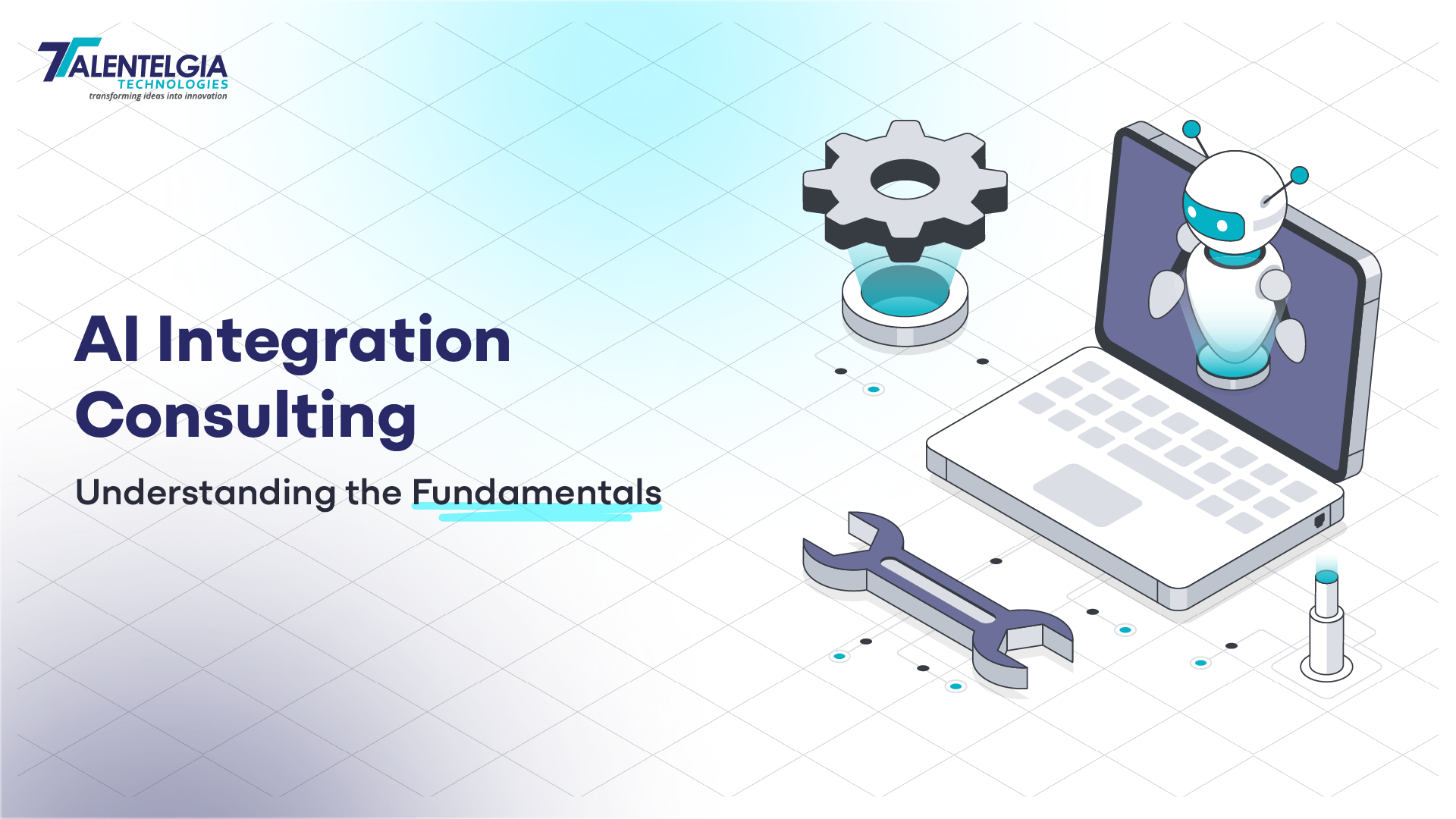User Experience (UX) Research is the key to designing products that resonate with users and align with their needs. Traditionally, UX research includes intensive interviews, detailed surveys, and rigorous tests. But with AI UX research tools, these processes are now helping businesses scale their operations.
AI is changing UX research by automatically analyzing large amounts of data. It provides actionable insights with unmatched speed and accuracy. From identifying user behavioral patterns to predicting user preferences, AI is streamlining research. This, in turn, is helping teams make rapid, data-powered decisions.
Keep reading to find out how you can use AI UX research tools to boost your research and help you create a user-centric experience.
Why use AI UX Research Tools?
AI UX research tools are streamlining business processes by automating repetitive tasks, analyzing behavior patterns, and delivering user insight faster. The main benefits of integrating AI in UX research include:
- Increased efficiency: AI accelerates data collection and analysis, reducing the time and effort required for manual research functions.
- Better accuracy: Machine learning algorithms can identify patterns and trends that may be overlooked by human researchers. This ensures more accurate insights.
- Scalability: AI UX research tools can handle huge amounts of user data. Therefore, they enable UX research capable of scaling basically in global markets.
- Quick response: They provide real-time insights from user interactions. This allows quick decision-making and more responsive product improvement.
Types of AI UX Research Tools
AI UX research tools are helping businesses by automating tiring tasks and giving detailed insights for an engaging user experience. The following table classifies some major types of AI UX research tools, showcasing the applications of artificial intelligence in user research. Leading UX design services providers use these tools for extensive research and deliver products well-received in the market.
| Type of Tool | Key AI Features |
|---|---|
| User Research Platform | Automated transcription, thematic tagging, AI-powered note-taking, report generation |
| Unmoderated User Testing Platform | Automatic analysis of tests, auto-generated reports, sentiment analysis |
| Micro-survey and In-app Feedback Platform | Analysis of open-ended responses, sentiment detection, keyword extraction |
| Customer Insights Hub | Automated transcription, theme identification, sentiment analysis, tagging |
| Research Repository and Analysis Platform | Automated transcription, smart tagging, pattern identification, summarization |
| All-in-one User Research Platform | Automated participant screening, real-time response analysis, thematic categorization |
| Collaborative Video Research Platform | Automated transcription, highlight generation, pattern identification |
| Documentation Analysis Platform | Gap identification, clarity improvement suggestions, content generation |
| Large Language Model (for diverse UX tasks) | Answering questions, content rewriting, idea generation, data analysis assistance |
| AI-powered Eye-tracking Simulation | Attention map generation, clarity score generation, areas of interest identification |
Top 10 UX Research Tools
Effective user experience (UX) research is important to design engaging products. With the advancements in technology, AI UX research tools have refined this process.
So, let us take a look at the 10 AI UX research tools. This will help you pick the right tools that align with your business needs and add more efficiency to your UX research process.
Merlin
Merlin is an AI-powered productivity tool designed to assist with task automation and data processing. Its purpose is to increase efficiency by providing automatic insights and material production to teams. Often used for marketing, customer assistance, and product development, this tool helps businesses streamline workflows, reduce manual efforts, and generate results quickly.
It can be integrated into various platforms, provides suggestions, and automatically repeats the data based on input. This tool allows companies to integrate AI solutions into their procedures without comprehensive training, making it suitable for teams of all sizes.
Key Features:
- Task automation to save time on repetitive work
- Integration with other productivity tools
- Real-time insights and content generation
- Customizable workflows to fit business needs
Pricing:
Pricing for Merlin varies depending on the required scale and specific features. You can expect a subscription-based model suitable for both small teams and enterprise-level AI business solutions.
Notion AI
This AI UX research tool integrates into the Notion workspace for content creation, note-taking, and project management. This allows you to automate writing, organize your tasks, and generate ideas more efficiently. Whether for team collaboration or personal productivity, Notion AI uses machine learning to suggest AI content, summarize long texts, and even generate to-do lists. This integration enhances the overall perception by adding AI-powered suggestions to simplify the workflow and promote productivity.
Key features:
- AI-powered content generation and brainstorming
- Automatic summarization of notes and documents
- Task management and organization suggestions
- Seamless integration into the Notion workspace
Pricing:
Notion AI is typically available as part of Notion’s paid plans, with a free version that offers limited features. Pricing for the Pro version starts at around $4 per month per user, with additional pricing for teams.
Loop panel
It is a feedback collection tool designed to give businesses real-time insight into how their users feel about their products. It works by allowing businesses to set up ongoing surveys and feedback loops that engage users during product interactions.
Loop panel is ideal for teams that require frequent user input to improve user experience over time, ensuring that product features are aligned with customers’ needs and expectations.
Key features:
- Continuous user feedback collection
- Real-time survey distribution and analysis
- Easy-to-use interface for creating feedback loops
- Integration with other product management tools
Pricing:
Loop panel works on a membership basis. Pricing usually starts at approximately $49 per month, with large teams or custom plans for more complex needs.
Maze
Maze is a usability testing platform that helps designers and researchers quickly validate their prototypes and user flows.
This supports remote tests, allowing you to collect data from real users without the need to schedule on-site sessions. Maze focuses on testing prototypes and designs in real-world scenarios, providing valuable data about user interactions, pain points, and preferences.
With detailed analytics, teams can make data-driven decisions that improve product design and user experience.
Key Features:
- Remote usability testing with real users
- Quick integration with prototypes (e.g., Figma, InVision)
- In-depth analytics to guide design decisions
- A collaborative platform for team-based insights
Pricing:
Maze offers a free basic version with limited features. Paid plans start at $25 per user per month for small teams, with enterprise pricing available upon request.
Sprig
Sprig is an AI UX research tool focusing on collecting in-product insights in real-time. This helps businesses to understand their users better. It integrates into web and mobile apps, collecting direct feedback from users as they interact with the product.
With Sprig, you can ask in-context questions and track user behavior for more personalized results. It is especially useful to customize user experiences during active product development cycles and ensure that you meet the expectations of the user at every stage.
Key features:
- Real-time in-product feedback collection
- Spontaneous integration with web and mobile apps
- Adaptable survey and user interaction tracking
- Actionable insights to improve UX/UI design
Pricing:
Sprig provides custom pricing based on the size and needs of the company, but specific plans begin at about $200 per month for basic features.
Dovetail
Dovetail helps teams analyze and share customer insights. This allows you to centralize qualitative research data, analyze patterns, and extract actionable insight. Dovetail makes it easy to collaborate with your team, as research conclusions are shared in a visible, accessible manner.
This AI UX research tool also integrates well with other tools such as Slack, Google Drive, and Airtel, allowing a smooth workflow in different stages of the UX process.
Key Features:
- Centralized platform for managing research data
- AI-powered analysis to uncover insights from raw data
- Collaboration tools for sharing findings across teams
- Integrations with various productivity tools
Pricing:
Dovetail offers a free version with limited functionality. Paid plans start at $29 per month per user, with high-level plans available for more advanced features.
Notably
Notably, is a user research tool that simplifies the process of organizing, analyzing, and interpreting user feedback. Teams can share interviews, tag major insights, and use easily digestible formats.
This is designed to streamline the UX research process by allowing businesses to focus on actionable insights instead of data management. Its collaborative features make it ideal for teams working in distant or different time areas.
Key Features:
- Interview transcription and tagging for easy analysis
- Collaborative research workspace
- Streamlined data visualization and reporting
- Powerful search and filtering capabilities
Pricing:
Notably offers a free version with limited features. Paid plans begin at $30 per month per user.
Qoqo
Qoqo is a user feedback platform that allows companies to collect insight through surveys, interviews, and reaction forms. This helps businesses refine their products based on direct user inputs, ensuring that the decisions are powered by real-world data.
QoqO is ideal for companies looking for quality assurance services to test new features or conduct initial-stage research. It has an intuitive interface which makes it easier for both businesses and users to engage.
Key features:
- Adaptable survey and reaction
- Real-time analytics and insights
- User-friendly interface for easy response collection
- Ideal for initial-stage product tests.
Pricing:
The value of Qoqo is usually custom, depending on your requirements. Basic plans often begin at around $49 per month.
UserDoc
Userdoc is a knowledge management tool that helps businesses create comprehensive product documentation, user guides, and FAQs. It enhances user experience by providing clear and accessible product information. Userdoc helps to streamline onboarding and customer assistance by reducing manual intervention. This customer is an excellent tool for businesses focused on improving self-service capabilities.
Key features:
- Create and manage user documentation and knowledge locations
- Adaptable guide and onboarding workflows
- Usable analytics to track user engagement
- Easy-to-update content as products evolve
Pricing:
UserDoc provides a free version with limited features. Paid plans begin at $19 per month, depending on users and required features.
ChatGPT
ChatGPT developed by OpenAI is a powerful language model that strengthens intelligent conversations, material production, and customer aid automation. In terms of UX research, ChatGPT can be used to automate the reaction collection, conduct user interviews, or analyze large sets of qualitative data for insight. By imitating human conversations, it can gather user’s opinions, answer questions, and improve overall user interaction experiences.
Key features:
- AI-driven conversation and response automation
- Survey, FAQ, and text generation for content
- Natural language understanding for practical analysis
- Customer aid and scalable for UX research
Pricing:
ChatGPT is usually free for personal use with a limited number of interactions. For businesses, OpenAI offers various membership levels, which start from GPT-3.5 and go to GPT-4, with pricing depending on the amount of use.
How to Choose the Right UX AI Research Tool?
Picking the right AI UX research tool is important to ensure that the UX research process is efficient, accurate, and effective. However, with different types of tools in the market, it is necessary to assess your specific requirements. Here are some important factors to consider while choosing the right UX AI research tools for your team.
- Define your research goals: Identify whether you need tools for usability testing, user feedback analysis, or behavioral tracking. Each tool fulfills different purposes, so understanding your goals will help reduce options.
- Evaluate data processing capabilities: Consider the capacity of the tool to handle large datasets and provide meaningful insights quickly. Choose a tool that can process user interaction in real-time to make fast decisions.
- Assess integration with other tools: Make sure the tool integrates well with your existing workflows and other research tools that you can already use. The spontaneous integration allows for a smooth research process.
- Check scalability: Select a tool that can scale with your growing data requirements, whether you are working with small user groups or doing research in global markets. Scalability ensures long-term efficiency and flexibility.
- User-friendliness and support: Choose a tool with an intuitive interface and strong customer aid. Ease of use ensures that your team can adopt the tool quickly, and strong support ensures you can solve the issues efficiently.
AI UX Research Tools Best Practices
User Experience (UX) research significantly benefits from artificial intelligence (AI) by streamlining processes and enhancing insights. Follow the below practices to maximize the effectiveness of AI tools while maintaining the integrity of the research process.
- Combine AI with human insight: While AI excels in processing big data sets, human expertise is necessary to explain the results and make meaningful decisions.
- Data privacy and ethics: Ensure compliance with data privacy rules like GDPR and CCPA. Adopt ethical AI practices to protect user information.
- Validate AI findings: AI models are not always 100% accurate. It is important to verify insight with qualitative research methods to ensure credibility.
- Continuous UX research: With AI, UX research becomes a continuous process, not a one-time function. This makes continuous refinement and improvement in design easier.
- Choose the right AI tool: Select the AI UX research tool based on your specific requirements. Whether it is to get better results, emotional analysis, or behavioral tracking.
Conclusion
The integration of AI UX research tools is driving the UX research process towards increased speed, accuracy, and scalability in the design process. As AI-operated tools become more advanced, they give UX researchers an insight into user behavior, preferences, and requirements. This leads to dynamic, attractive, and user-friendly designs that keep up with the expectations of the end users.
By automating repetitive tasks, analyzing large amounts of data, and providing real-time insights, AI helps businesses make more accurate decisions.
Further, as the demand for AI development services increases technology increases, its role in UX research will become more important. AI UX research tools help businesses deliver enhanced user experiences and ensure high customer satisfaction and retention rates.
Therefore, adopting AI UX research tools is now necessary for businesses to create products that align with user needs.


 Healthcare App Development Services
Healthcare App Development Services
 Real Estate Web Development Services
Real Estate Web Development Services
 E-Commerce App Development Services
E-Commerce App Development Services E-Commerce Web Development Services
E-Commerce Web Development Services Blockchain E-commerce Development Company
Blockchain E-commerce Development Company
 Fintech App Development Services
Fintech App Development Services Fintech Web Development
Fintech Web Development Blockchain Fintech Development Company
Blockchain Fintech Development Company
 E-Learning App Development Services
E-Learning App Development Services
 Restaurant App Development Company
Restaurant App Development Company
 Mobile Game Development Company
Mobile Game Development Company
 Travel App Development Company
Travel App Development Company
 Automotive Web Design
Automotive Web Design
 AI Traffic Management System
AI Traffic Management System
 AI Inventory Management Software
AI Inventory Management Software
 AI Software Development
AI Software Development  AI Development Company
AI Development Company  AI App Development Services
AI App Development Services  ChatGPT integration services
ChatGPT integration services  AI Integration Services
AI Integration Services  Generative AI Development Services
Generative AI Development Services  Natural Language Processing Company
Natural Language Processing Company Machine Learning Development
Machine Learning Development  Machine learning consulting services
Machine learning consulting services  Blockchain Development
Blockchain Development  Blockchain Software Development
Blockchain Software Development  Smart Contract Development Company
Smart Contract Development Company  NFT Marketplace Development Services
NFT Marketplace Development Services  Asset Tokenization Company
Asset Tokenization Company DeFi Wallet Development Company
DeFi Wallet Development Company Mobile App Development
Mobile App Development  IOS App Development
IOS App Development  Android App Development
Android App Development  Cross-Platform App Development
Cross-Platform App Development  Augmented Reality (AR) App Development
Augmented Reality (AR) App Development  Virtual Reality (VR) App Development
Virtual Reality (VR) App Development  Web App Development
Web App Development  SaaS App Development
SaaS App Development Flutter
Flutter  React Native
React Native  Swift (IOS)
Swift (IOS)  Kotlin (Android)
Kotlin (Android)  Mean Stack Development
Mean Stack Development  AngularJS Development
AngularJS Development  MongoDB Development
MongoDB Development  Nodejs Development
Nodejs Development  Database Development
Database Development Ruby on Rails Development
Ruby on Rails Development Expressjs Development
Expressjs Development  Full Stack Development
Full Stack Development  Web Development Services
Web Development Services  Laravel Development
Laravel Development  LAMP Development
LAMP Development  Custom PHP Development
Custom PHP Development  .Net Development
.Net Development  User Experience Design Services
User Experience Design Services  User Interface Design Services
User Interface Design Services  Automated Testing
Automated Testing  Manual Testing
Manual Testing  Digital Marketing Services
Digital Marketing Services 
 Ride-Sharing And Taxi Services
Ride-Sharing And Taxi Services Food Delivery Services
Food Delivery Services Grocery Delivery Services
Grocery Delivery Services Transportation And Logistics
Transportation And Logistics Car Wash App
Car Wash App Home Services App
Home Services App ERP Development Services
ERP Development Services CMS Development Services
CMS Development Services LMS Development
LMS Development CRM Development
CRM Development DevOps Development Services
DevOps Development Services AI Business Solutions
AI Business Solutions AI Cloud Solutions
AI Cloud Solutions AI Chatbot Development
AI Chatbot Development API Development
API Development Blockchain Product Development
Blockchain Product Development Cryptocurrency Wallet Development
Cryptocurrency Wallet Development About Talentelgia
About Talentelgia  Our Team
Our Team  Our Culture
Our Culture 
 Healthcare App Development Services
Healthcare App Development Services Real Estate Web Development Services
Real Estate Web Development Services E-Commerce App Development Services
E-Commerce App Development Services E-Commerce Web Development Services
E-Commerce Web Development Services Blockchain E-commerce
Development Company
Blockchain E-commerce
Development Company Fintech App Development Services
Fintech App Development Services Finance Web Development
Finance Web Development Blockchain Fintech
Development Company
Blockchain Fintech
Development Company E-Learning App Development Services
E-Learning App Development Services Restaurant App Development Company
Restaurant App Development Company Mobile Game Development Company
Mobile Game Development Company Travel App Development Company
Travel App Development Company Automotive Web Design
Automotive Web Design AI Traffic Management System
AI Traffic Management System AI Inventory Management Software
AI Inventory Management Software AI Software Development
AI Software Development AI Development Company
AI Development Company ChatGPT integration services
ChatGPT integration services AI Integration Services
AI Integration Services Machine Learning Development
Machine Learning Development Machine learning consulting services
Machine learning consulting services Blockchain Development
Blockchain Development Blockchain Software Development
Blockchain Software Development Smart contract development company
Smart contract development company NFT marketplace development services
NFT marketplace development services IOS App Development
IOS App Development Android App Development
Android App Development Cross-Platform App Development
Cross-Platform App Development Augmented Reality (AR) App
Development
Augmented Reality (AR) App
Development Virtual Reality (VR) App Development
Virtual Reality (VR) App Development Web App Development
Web App Development Flutter
Flutter React
Native
React
Native Swift
(IOS)
Swift
(IOS) Kotlin (Android)
Kotlin (Android) MEAN Stack Development
MEAN Stack Development AngularJS Development
AngularJS Development MongoDB Development
MongoDB Development Nodejs Development
Nodejs Development Database development services
Database development services Ruby on Rails Development services
Ruby on Rails Development services Expressjs Development
Expressjs Development Full Stack Development
Full Stack Development Web Development Services
Web Development Services Laravel Development
Laravel Development LAMP
Development
LAMP
Development Custom PHP Development
Custom PHP Development User Experience Design Services
User Experience Design Services User Interface Design Services
User Interface Design Services Automated Testing
Automated Testing Manual
Testing
Manual
Testing About Talentelgia
About Talentelgia Our Team
Our Team Our Culture
Our Culture

















 Write us on:
Write us on:  Business queries:
Business queries:  HR:
HR: 




